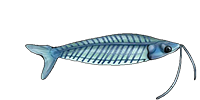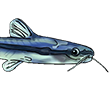Will corys eat fry?
- biomechmonster
- Posts: 118
- Joined: 20 Nov 2003, 00:42
- My cats species list: 3 (i:0, k:0)
- Location 1: Chicago, IL
Will corys eat fry?
Ok first, will corys eat fry? My husband and I have a 20g long we're thinking of turning into a fry tank (cichlid fry). But we want something to live in there 24/7 to keep the bacteria populations healthy. The tank will have a sponge filter.
I was thinking of a small group of dwarf corys, maybe 4-5. What do you think?
Also what kind of substrate would the corys prefer, other than sand? Unfortunately I have tried sand and HATED it--it clogs filters and drains and is impossible to gravel-vacuum. Never again unless the tank is planted.
If not corys, any other suggestions? Thank you.
I was thinking of a small group of dwarf corys, maybe 4-5. What do you think?
Also what kind of substrate would the corys prefer, other than sand? Unfortunately I have tried sand and HATED it--it clogs filters and drains and is impossible to gravel-vacuum. Never again unless the tank is planted.
If not corys, any other suggestions? Thank you.
"Mr. Vaughan, what we are dealing with here is a perfect engine, er... an eating machine. It's really a miracle of evolution."
-
Mike_Noren
- Posts: 1395
- Joined: 25 Jul 2003, 21:40
- I've donated: $30.00!
- My articles: 1
- My images: 37
- My cats species list: 5 (i:0, k:0)
- Spotted: 9
- Location 1: Sweden
- Location 2: Sweden
I don't how universal it is, but I keep C. pygmaeus with a species of dwarf minnow, and the minnows are increasing in numbers. However, the minnow-larvae stay at the surface when very small, where the cories rarely go.
I have cherry shrimp in the same tank, and they're increasing too - but I've never seen any larvae, so maybe they're also just really good at staying out of the cories way when small.
But - my impression is that C. pygmaeus is pretty safe with fish fry.
However, I'm doubtful the pygmaeus could handle having cichlids breeding in the same tank. They're very small and very peaceful fish.
I have cherry shrimp in the same tank, and they're increasing too - but I've never seen any larvae, so maybe they're also just really good at staying out of the cories way when small.
But - my impression is that C. pygmaeus is pretty safe with fish fry.
However, I'm doubtful the pygmaeus could handle having cichlids breeding in the same tank. They're very small and very peaceful fish.
- biomechmonster
- Posts: 118
- Joined: 20 Nov 2003, 00:42
- My cats species list: 3 (i:0, k:0)
- Location 1: Chicago, IL
No cichlids will be breeding in that tank; it will be a fry grow-out tank only.
Good to know the corys don't eat fry!
Could you recommend a good dwarf species for a 20? I know they like being in groups so I'd like to keep 4-5 or more if possible together. Keep in mind there will be no other fish besides tiny fry.
Good to know the corys don't eat fry!
Could you recommend a good dwarf species for a 20? I know they like being in groups so I'd like to keep 4-5 or more if possible together. Keep in mind there will be no other fish besides tiny fry.
"Mr. Vaughan, what we are dealing with here is a perfect engine, er... an eating machine. It's really a miracle of evolution."
If you feed them really well, they won't eat them. Some species - e.g. Sterbai - like caviar a lot, but if they are well fed, the loses are negligible.biomechmonster wrote:No c*****ds will be breeding in that tank; it will be a fry grow-out tank only.
Good to know the corys don't eat fry!
Could you recommend a good dwarf species for a 20? I know they like being in groups so I'd like to keep 4-5 or more if possible together. Keep in mind there will be no other fish besides tiny fry.
- apistomaster
- Posts: 4735
- Joined: 10 Jun 2006, 14:26
- I've donated: $90.00!
- My articles: 1
- My cats species list: 12 (i:0, k:0)
- My Wishlist: 1
- Location 1: Clarkston, WA, USA
- Location 2: Clarkston, WA, USA
- Interests: Aquaculture and flyfishing
Of the three most commonly available species of dwarf Corys, I think C. habrosus is the most bottom oriented. C. hastatus and pygmeus are more mid to lower level water oriented but all three are harmless to most things. I would think free swimming Cichlid fry are immune from any danger these species could possibly pose.
Avid Trout fly fisherman. ·´¯`·...¸><)))º>
-
hellocatfish
- Posts: 227
- Joined: 08 Dec 2006, 21:49
- I've donated: $10.00!
- My cats species list: 5 (i:0, k:0)
- Location 1: Mid-Atlantic Region, USA
As far as substrate goes, I recently got an Estes gravel for my daughter's betta tank. I've used Estes before and hated it, because the grains were of irregular size and trapped the food. But this particular Estes gravel is smooth, small-grained but not as small as sand, and coated. I think cories would do well in it. I don't remember which type of Estes it was, and it was available in small bags, about 3 pounds, I think. But it shouldn't be too expensive to get enough to cover the bottom of a 20galLong. I just set up one of those myself and found I needed to use very little substrate to get adequate coverage on the bottom. If you're not going with plants you don't want it too deep anyway.
You can go to their website http://www.estesco.com and download their pdf format catalog. If you do, I think it's the Designer Blends and Pearls, Lavender color, that we got. The hot pink is the most ideal size and smoothness for cories, when I saw it in person. Um...don't know how you'd feel about the color, though. You might want to check out their Nature Blends line.
You might want to check out their Nature Blends line.
It was the SpectraStone that I had trouble with.
I hope that helps.
You can go to their website http://www.estesco.com and download their pdf format catalog. If you do, I think it's the Designer Blends and Pearls, Lavender color, that we got. The hot pink is the most ideal size and smoothness for cories, when I saw it in person. Um...don't know how you'd feel about the color, though.
It was the SpectraStone that I had trouble with.
I hope that helps.
Tanks: SeaClear Acrylic 40 US gallons, Eheim Ecco 2236, Eheim Classic 2215, Fine gravel & EcoComplete: 3 Albino Aeneus, 4 Green Aeneus (NOT Brochis) 6 Peppers, 3 Sterba, 1 Elegans, 10 Danios, 3 panda cories, 1 cichlid.
5 gal betta tank: 1 male betta
50 gallon SeaClear Eheim 2213, Eheim 2215, fine gravel: 3 baby goldfish (2 Moors, 1 Oranda in QT)
5 gal betta tank: 1 male betta
50 gallon SeaClear Eheim 2213, Eheim 2215, fine gravel: 3 baby goldfish (2 Moors, 1 Oranda in QT)
-
Mike_Noren
- Posts: 1395
- Joined: 25 Jul 2003, 21:40
- I've donated: $30.00!
- My articles: 1
- My images: 37
- My cats species list: 5 (i:0, k:0)
- Spotted: 9
- Location 1: Sweden
- Location 2: Sweden
- apistomaster
- Posts: 4735
- Joined: 10 Jun 2006, 14:26
- I've donated: $90.00!
- My articles: 1
- My cats species list: 12 (i:0, k:0)
- My Wishlist: 1
- Location 1: Clarkston, WA, USA
- Location 2: Clarkston, WA, USA
- Interests: Aquaculture and flyfishing
Anything is possible but the only times I have had only Corydoras species eat any fry was their own newly hatched larvae and those of small larvae of Tetras or similarly small and helpless larvae before they became fry swimming. I have never heard or seen a Cory aeneaus or any other Cory feed on newborn livebearer fry but there are exceptions to every general rule.
Estes coated sands and gravels are harmless but they are poor substrates if your do want planted tanks. The coated substrate materials go hand in hand with plastic plants. With substrate fertilzation and time for some detrital accumulations mosts plants will grown in them. There are just some advantages to natural substrates. Natural grains provide micronutrients and micro texture that rooted plants' root hairs use to help anchor themselves and generally promote better and faster growth of plants.
Regardless of the substrate it should be fine and smooth enough to be easy on the barbls of Corys.
Estes coated sands and gravels are harmless but they are poor substrates if your do want planted tanks. The coated substrate materials go hand in hand with plastic plants. With substrate fertilzation and time for some detrital accumulations mosts plants will grown in them. There are just some advantages to natural substrates. Natural grains provide micronutrients and micro texture that rooted plants' root hairs use to help anchor themselves and generally promote better and faster growth of plants.
Regardless of the substrate it should be fine and smooth enough to be easy on the barbls of Corys.
Avid Trout fly fisherman. ·´¯`·...¸><)))º>




